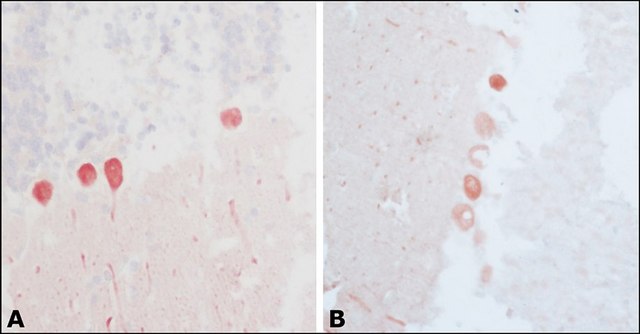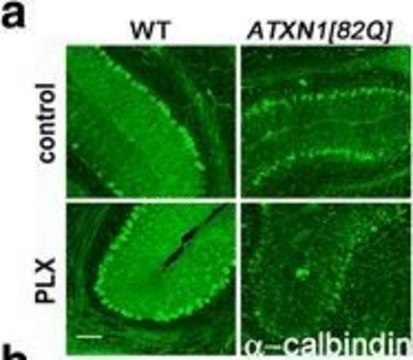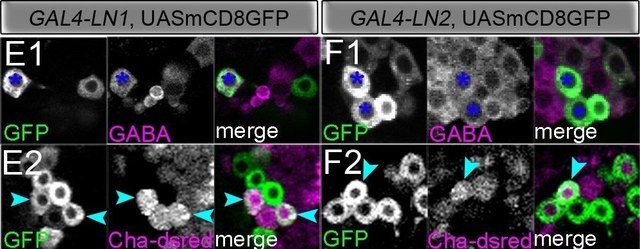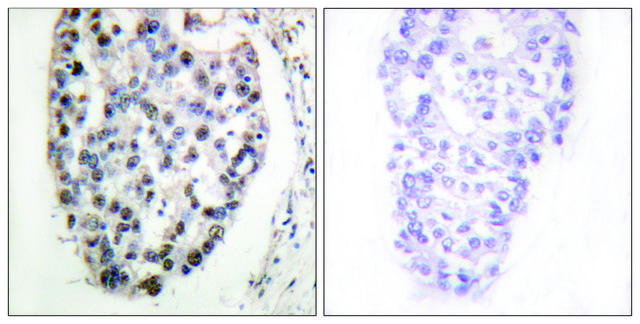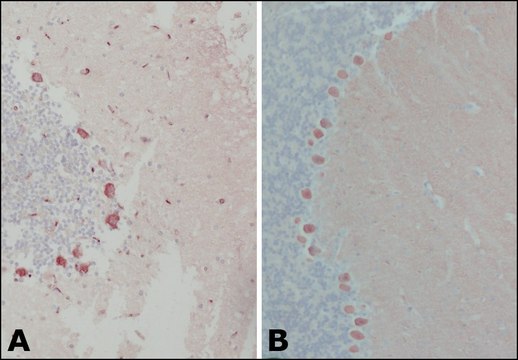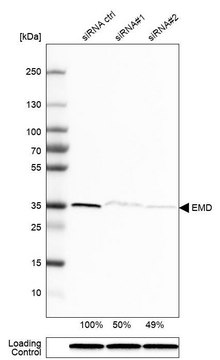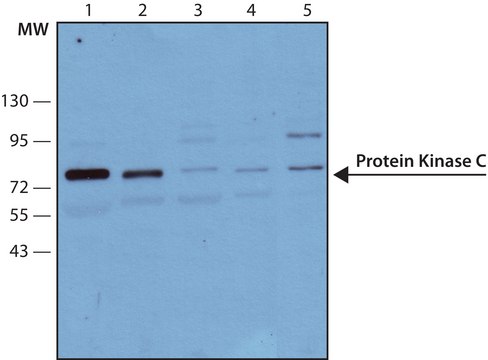IHCR1013-6
Anti-Calbindin D-28K Antibody, prediluted
Chemicon®, from rabbit
Sign Into View Organizational & Contract Pricing
All Photos(1)
UNSPSC Code:
12352203
eCl@ss:
32160702
Recommended Products
biological source
rabbit
antibody form
purified antibody
antibody product type
primary antibodies
clone
polyclonal
species reactivity
human
manufacturer/tradename
Chemicon®
technique(s)
immunohistochemistry: suitable (paraffin)
NCBI accession no.
UniProt accession no.
shipped in
wet ice
target post-translational modification
unmodified
Gene Information
human ... CALB1(793)
General description
Calbindin D28k is a member of a large family of intracellular calcium-binding proteins of the EF-hand related to calmodulin and troponin-C. The biological roles of Calbindin D28k include, calcium regulation (including calcium transport and uptake, calcification of bone and teeth) and calcium related signalling in neurons and transiently in embryological development. This calbindin also has a role in protecting neurons from apoptotic cell death. Disregulation of this calbindin protein relates to several disease states. Decline in calbindin D28k in hippocampal dentate granule cells correlates with the kindling model for epilepsy. Calbindin D28k immunoreactivity is specifically absent from neuronal poplulations lost early in ALS, while substantial loss of neurons which do contain the protein occur in patients with Huntington′s disease.
Specificity
Calbindin. Shows no cross-reactivity to calretinin by Western blot. The antibody produces specific staining of cerebellum Purkinje cells, molecular layer dendrites and axonal fibers, stains cell bodies and fibers in neuronal subpopulations.
Immunogen
Purified recombinant calbindin.
Application
Antibody is prediluted and ready to use for Immunohistochemistry of formalin-fixed, paraffin-embedded tissues.
Pretreatment: Heat Induced Epitope Retrieval (HIER). Recommend Citrate Buffer, pH 6.0 (Cat. No. 21545). No signal was detected without Epitope retrieval.
Incubation: 30 minutes with IHC Select Detection Kits.
Calbindin has been prediluted for use as the primary antibody with Chemicon′s IHC Select Detection Kits and Protocols (Catalog Nos. DAB050, DET-HP1000, APR050, and DET-APR1000), but other supplier′s IHC detection systems may be used. For optimized protocol details, visit www.chemicon.com and select the protocols link under Cat. No.IHCR1013-6.
Pretreatment: Heat Induced Epitope Retrieval (HIER). Recommend Citrate Buffer, pH 6.0 (Cat. No. 21545). No signal was detected without Epitope retrieval.
Incubation: 30 minutes with IHC Select Detection Kits.
Calbindin has been prediluted for use as the primary antibody with Chemicon′s IHC Select Detection Kits and Protocols (Catalog Nos. DAB050, DET-HP1000, APR050, and DET-APR1000), but other supplier′s IHC detection systems may be used. For optimized protocol details, visit www.chemicon.com and select the protocols link under Cat. No.IHCR1013-6.
Detect Calbindin D-28K using this Anti-Calbindin D-28K Antibody, prediluted validated for use in IH(P).
Research Category
Neuroscience
Neuroscience
Research Sub Category
Neuronal & Glial Markers
Neuronal & Glial Markers
Physical form
Format: Purified
Liquid diluted in PBS, pH 7.2 with stabilizers, 0.2% Tween 20, and 0.1% ProClin 300 as preservative.
Storage and Stability
Maintain at 2-8oC. Refer to vial for expiration dating.
Legal Information
CHEMICON is a registered trademark of Merck KGaA, Darmstadt, Germany
Disclaimer
Unless otherwise stated in our catalog or other company documentation accompanying the product(s), our products are intended for research use only and are not to be used for any other purpose, which includes but is not limited to, unauthorized commercial uses, in vitro diagnostic uses, ex vivo or in vivo therapeutic uses or any type of consumption or application to humans or animals.
recommended
Product No.
Description
Pricing
Signal Word
Warning
Hazard Statements
Precautionary Statements
Hazard Classifications
Aquatic Chronic 3 - Skin Sens. 1
WGK
WGK 2
Flash Point(F)
Not applicable
Flash Point(C)
Not applicable
Certificates of Analysis (COA)
Search for Certificates of Analysis (COA) by entering the products Lot/Batch Number. Lot and Batch Numbers can be found on a product’s label following the words ‘Lot’ or ‘Batch’.
Already Own This Product?
Find documentation for the products that you have recently purchased in the Document Library.
Alleene V Strickland et al.
Journal of the peripheral nervous system : JPNS, 19(2), 152-164 (2014-05-28)
Charcot-Marie-Tooth disease (CMT) comprises a group of heterogeneous peripheral axonopathies affecting 1 in 2,500 individuals. As mutations in several genes cause axonal degeneration in CMT type 2, mutations in mitofusin 2 (MFN2) account for approximately 90% of the most severe
Eri Iwasawa et al.
The Journal of neuroscience : the official journal of the Society for Neuroscience, 42(9), 1820-1844 (2022-01-08)
Neonatal hydrocephalus presents with various degrees of neuroinflammation and long-term neurologic deficits in surgically treated patients, provoking a need for additional medical treatment. We previously reported elevated neuroinflammation and severe periventricular white matter damage in the progressive hydrocephalus (prh) mutant
Mario G Oyola et al.
Endocrinology, 156(6), 2150-2161 (2015-04-08)
In addition to androgenic properties mediated via androgen receptors, dihydrotestosterone (DHT) also regulates estrogenic functions via an alternate pathway. These estrogenic functions of DHT are mediated by its metabolite 5α-androstane-3β, 17β-diol (3β-diol) binding to estrogen receptor β (ERβ). CYP7B1 enzyme
Our team of scientists has experience in all areas of research including Life Science, Material Science, Chemical Synthesis, Chromatography, Analytical and many others.
Contact Technical Service